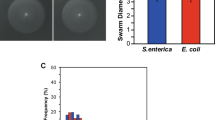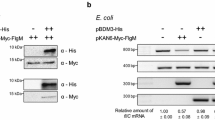Abstract
More than 50 genes are required for flagellar formation and function in Salmonella typhimurium. According to the cascade model of the flagellar regulon, the flagellar operons are divided into three classes, 1, 2, and 3, with reference to their relative positions in the transcriptional hierarchy. This sequential transcription is coupled to the assembly process of the flagellar structure, that is, genes involved in formation of the hook-basal body complex belong to the class-2 operons, whereas those involved in formation of filament belong to the class-3 operons. The fliA gene encodes an alternative sigma factor specific for transcription of the class-3 operons. A negative regulatory gene, flgM, which is responsible for the coupling of expression of class-3 operons to flagellar assembly, encodes an anti-sigma factor that binds to FHA and prevents its association with RNA polymerase core enzyme. In the present study, we showed that the flgM gene is transcribed from two different promoters: one is its own class-3 promoter and the other is the class-2 promoter for the upstream gene, flgA. Furthermore, we showed that FlgM is excreted into culture medium from cells of the wild-type strain and of class-3 mutants that can produce complete hook-basal body structures. On the other hand, FlgM is not excreted from mutants defective in the hook-basal body genes. These results indicate that FIgM is excreted from the cells through the flagellar substructures that are formed by the function of the hook-basal body genes. We believe that this is the mechanism by which FlgM can monitor the assembly state of flagellar structure and couple flagellar gene expression to flagellar assembly.
Similar content being viewed by others
References
Amann E, Ochs B, Abel K-J (1988) Tightly regulated tac promoter vectors useful for the expression of unfused and fused proteins in Escherichia coli. Gene 69:301–315
Bolivar F, Rodriguez RL, Greene PJ, Betrach MC, Heynecker HL, Boyer HW, Crosa JH, Falkow S (1977) Construction and characterization of new cloning vehicles. II. A multipurpose cloning system. Gene 2:95–113
Close TJ, Rodriguez RL (1982) Construction and characterization of the chloramphenicol-resistance gene cartridge: a new approach to the transcriptional mapping of extrachromosomal elements. Gene 20:305–316
Gillen KL, Hughes KT (1991a) Negative regulatory loci coupling flagellin synthesis to flagellar assembly in Salmonella typhimurium. J Bacteriol 173:2301–2310
Gillen KL, Hughes KT (1991b) Molecular characterization of flgM, a gene encoding a negative regulator of flagellin synthesis in Salmonella typhimurium. J Bacteriol 173:6453–6459
Helmann JD, Chamberlin MJ (1987) DNA sequence analysis suggests that expression of flagellar and chemotaxis genes in Escherichia coli and Salmonella typhimurium is controlled by an alternative sigma factor. Proc Natl Acad Sci USA 84:6422–6424
Homma M, Fujita H, Yamaguchi S, Iino T (1984a) Excretion of unassembled flagellin by Salmonella typhimurium mutants deficient in hook-associated proteins. J Bacteriol 159:1056–1059
Homma M, Kutsukake K, Iino T, Yamaguchi S (1984b) Hook-associated proteins essential for flagellar filament formation in Salmonella typhimurium. J Bacteriol 157:100–108
Homma M, Iino T, Kutsukake K, Yamaguchi S (1986) In vitro reconstruction of flagellar filaments onto hooks of filamentsless mutants of Salmonella typhimurium by addition of hookassociated proteins. Proc Natl Acad Sci USA 63:6169–6173
Iino T (1969) Polarity of flagellar growth in Salmonella. J Gen Microbiol 56:227–239
Ikeda T, Asakura S, Kamiya R (1985) “Cap” on the tip of Salmonella flagella. J Mol Biol 184:735–737
Jinks-Robertson S, Nomura M (1987) Ribosomes and tRNA. In: Neidhardt FC (ed) Escherichia coli and Salmonella typhimurium, cellular and molecular biology. American Society for Microbiology, Washington, DC, pp 1358–1385
Komeda Y, Kutsukake K, Iino T (1980) Definition of additional flagellar genes in Escherichia coli K12. Genetics 94:277–290
Kubori T, Shimamoto N, Yamaguchi S, Namba K, Aizawa S (1992) Morphological pathway of flagellar assembly in Salmonella typhimurium. J Mol Biol 226:433–446
Kutsukake K, Suzuki T, Yamaguchi S, Iino T (1979) Role of gene flaFV on flagellar hook formation in Salmonella typhimurium. J Bacteriol 140:267–275
Kutsukake K, Nakao T, Iino T (1985) A gene for DNA invertase and an invertible DNA in Escherichia coli. Gene 34:343–350
Kutsukake K, Ohya Y, Yamaguchi S, Iino T (1988) Operon structure of flagellar genes in Salmonella typhimurium. Mol Gen Genet 214:11–15
Kutsukake K, Ohya Y, Iino T (1990) Transcriptional analysis of the flagellar regulon of Salmonella typhimurium. J Bacteriol 172:741–747
Kutsukake K, Okada T, Yokoseki T, Iino T (1994) Sequence analysis of the flgA gene and its adjacent region in Salmonella typhimurium, and identification of another flagellar gene, flgN. Gene: in press
Kuwajima G, Kawagishi I, Homma M, Asaka J, Kondo E, Macnab RM (1989) Export of the N-terminal fragment of Escherichia coli flagellin by a flagellum-specific pathway. Proc Natl Acad Sci USA 86:4953–4957
Laemmli UK (1970) Cleavage of structural proteins during the assembly of the head of bacteriophage T4. Nature 227:680–685
Macnab RM (1992) Genetics and biogenesis of bacterial flagella. Annu Rev Genet 26:131–158
Maloy SR, Roth JR (1983) Regulation of proline utilization in Salmonella typhimurium: Characterization of put::Mud(Ap,lac) operon fusions. J Bacteriol 154:561–568
Ohnishi K, Kutsukake K, Suzuki H, Iino T (1990) Gene fliA encodes an alternative sigma factor specific for flagellar operons in Salmonella typhimurium. Mol Gen Genet 221:139–147
Ohnishi K, Kutsukake K, Suzuki T, Iino T (1992) A novel transcriptional regulation mechanism in the flagellar regulon of Salmonella typhimurium: an anti-sigma factor inhibits the activity of the flagellum-specific sigma factor, σF. Mol Microbiol 6:3149–3157
Platt T, Müller-Hill B, Miller JH (1972) Assay of β-galactosidase. In: Miller JH (ed) Experiments in molecular genetics. Cold Spring Harbor Laboratory Press, Cold Spring Harbor, New York, pp 352–355
Shaw WV (1975) Chloramphenicol acetyltransferase from chloramphenicol-resistant bacteria. Methods Enzymol 43:737–755
Suzuki T, Iino T, Horiguchi T, Yamaguchi S (1978) Incomplete flagellar structures in nonflagellate mutants of Salmonella typhimurium. J Bacteriol 133:904–915
Author information
Authors and Affiliations
Additional information
Communicated by M. Sekiguchi
Rights and permissions
About this article
Cite this article
Kutsukake, K. Excretion of the anti-sigma factor through a flagellar substructure couples flagellar gene expression with flagellar assembly in Salmonella typhimurium . Molec. Gen. Genet. 243, 605–612 (1994). https://doi.org/10.1007/BF00279569
Received:
Accepted:
Issue Date:
DOI: https://doi.org/10.1007/BF00279569




